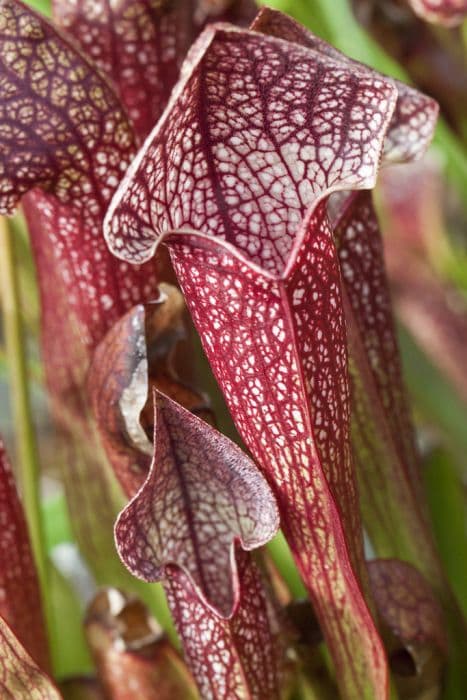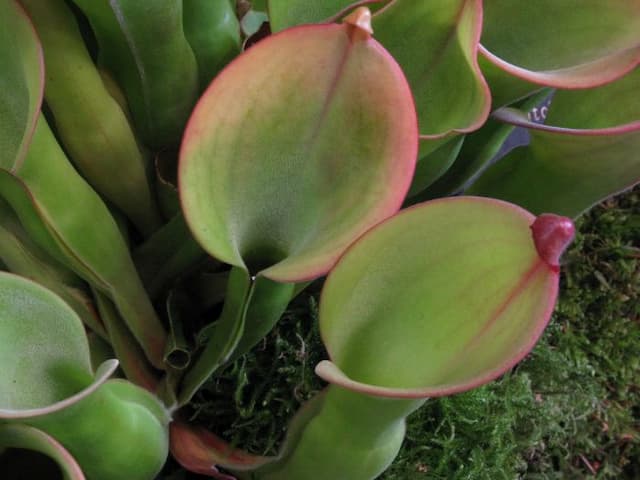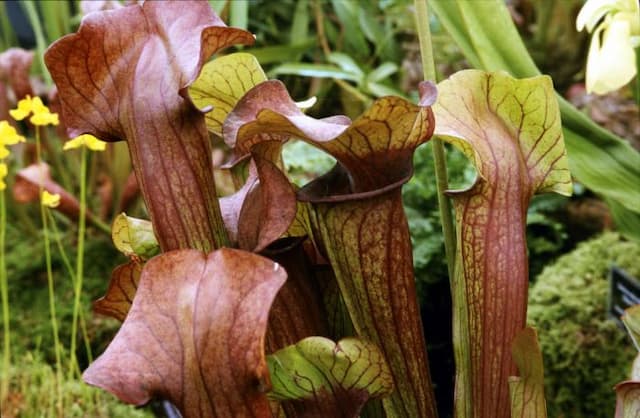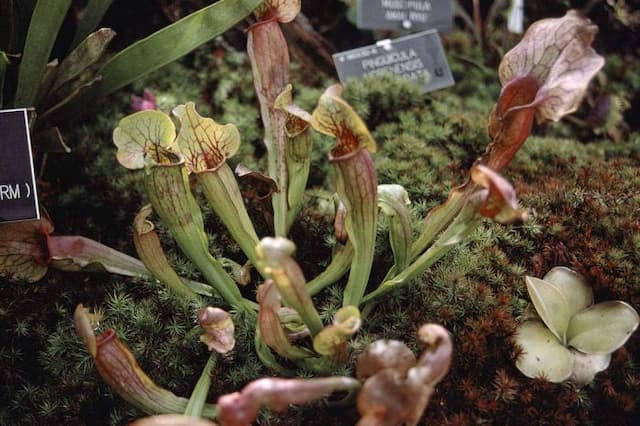Cobra lily Darlingtonia californica

ABOUT
The plant commonly known as the California pitcher plant is a remarkable and unusual carnivorous plant unmistakable in appearance. The most striking feature is its leaves, which are modified into tubular pitchers. These rounded pitchers are green, often with reddish or purplish veins running along their length, creating a marbled or mottled effect. The pitchers twist gracefully and flare into a bulbous, hollow structure at the top, resembling a hood or cobra's head. This hood is characterized by translucent patches that confuse prey and a large, downward-pointing appendage above the entrance. Each pitcher is adorned with numerous fine hair-like structures pointing downward, which guide insects further into the trap. At the bottom of the pitcher is a pool of digestive enzymes where the plant digests its captured prey for nutrition. Unlike other pitcher plants, it does not collect water in its pitcher, but it secretes the digestive fluid itself. The California pitcher plant also produces flowers that are less noticeable compared to its striking leaves. The flowers hang upside down and are yellowish to reddish-brown. They have an umbrella-like structure with numerous narrow, pointed petals radiating outward. These flowers dangle on long, solitary stalks that rise above the pitchers. Despite its captivating design, it does not exude the typical sweet fragrance most flowers have; its scent is not very appealing to humans but attracts insects for pollination.
About this plant
 Names
NamesFamily
Sarraceniaceae.
Synonyms
California Pitcher Plant, Cobra Lily, Cobra Plant.
Common names
Chrysamphora californica, Darlingtonia californiformis, Darlingtonia uncinata.
 Toxicity
ToxicityTo humans
The plant commonly known as the California pitcher plant is not known to be toxic to humans.
To pets
The California pitcher plant is not known to be toxic to pets.
 Characteristics
CharacteristicsLife cycle
Perennials
Foliage type
Evergreen
Color of leaves
Green
Flower color
Yellow
Height
3 feet (0.91 meters)
Spread
1 foot (0.3 meters)
Plant type
Herb
Hardiness zones
7
Native area
North America
Benefits
 General Benefits
General Benefits- Educational interest: California Pitcher Plant offers a fascinating opportunity to learn about carnivorous plants and their unique adaptations for survival.
- Ecological importance: It plays a specific role in its habitat by helping to control insect populations.
- Conservation value: Being a rare and unusual species, it helps to raise awareness about plant diversity and the need for habitat protection.
- Horticultural novelty: Due to its unique appearance and insectivorous nature, it's a curiosity and conversation starter in gardens.
- Scientific research: It provides a subject for scientific study, particularly in the fields of botany and ecology.
- Wildlife support: The plant creates a microhabitat for certain insects and potentially for other small organisms.
 Medical Properties
Medical PropertiesThis plant is not used for medical purposes.
 Air-purifying Qualities
Air-purifying QualitiesThis plant is not specifically known for air purifying qualities.
 Other Uses
Other Uses- Darlingtonia californica, commonly known as the Cobra Lily, can be used as a natural insect control agent by attracting and digesting various types of pests, particularly flying insects.
- It can serve as an educational tool for biology students and enthusiasts studying carnivorous plants' adaptations, evolution, and ecology.
- The Cobra Lily is sometimes used in landscaping for ornamental purposes due to its unique appearance.
- It can be a compelling photographic subject for nature photographers, especially given its unusual shape and insect-trapping mechanism.
- Hobbyists may use the Cobra Lily in terrariums and carnivorous plant collections to create diverse displays.
- The plant can serve as a biological indicator for ecological research, as its presence often indicates a specific wetland habitat type.
- It is occasionally used in thematic garden designs, such as bog or water gardens, where its specific growing conditions can be met.
- The plant's unique shape can inspire artists and designers in fields ranging from fashion to architecture.
- It may occasionally play a role in science outreach and conservation education, teaching about plant diversity and the importance of habitat protection.
- The Cobra Lily's nectar, while minimal, could theoretically be investigated for its constituent chemicals, as it has evolved to be particularly alluring to insects.
Interesting Facts
 Feng Shui
Feng ShuiThe California Pitcher Plant is not used in Feng Shui practice.
 Zodiac Sign Compitability
Zodiac Sign CompitabilityThe California Pitcher Plant is not used in astrology practice.
 Plant Symbolism
Plant Symbolism- Mystery: Darlingtonia californica, commonly known as the California pitcher plant, has a unique and somewhat alien appearance, which often symbolizes the mysterious and the unknown aspects of nature.
- Cunning: As a carnivorous plant, the California pitcher plant uses its modified leaves to trap and digest insects. This can symbolize cunning and strategy in the way it lures and captures its prey.
- Adaptation: The California pitcher plant symbolizes adaptation because it has evolved to thrive in nutrient-poor soil by deriving nutrients from insects instead — representing the ability to adapt and make the most of available resources.
- Uniqueness: With its uncommon method of survival and distinct appearance, the California pitcher plant stands as a symbol of uniqueness, celebrating divergence from the norm.
- Deception: The plant employs deceptive tactics to attract insects, often making it a symbol of illusion or deception in the natural world.
 Water
WaterThe Cobra Plant should be watered with cold, pure water; avoid using tap water if it's high in minerals. It's essential to keep the soil moist but not waterlogged, so watering once or twice a week is sufficient. The best method is to use the tray method, where you fill a tray with about an inch of water and let the pot sit in it, allowing the water to wick up through the drainage holes. During the hotter summer months, you might need to use up to two gallons per week, while in the cooler seasons, less water will be required. Always check the top inch of soil for dryness as a guide for when to water next.
 Light
LightThe Cobra Plant thrives in bright, indirect sunlight or partial shade. Direct sunlight should be avoided, especially during the hottest part of the day, as it can scorch the leaves. A spot that receives filtered light or morning sun with afternoon shade is ideal for this carnivorous plant.
 Temperature
TemperatureThe Cobra Plant prefers cooler temperatures, generally between 70 to 80 degrees Fahrenheit during the day and not dropping below 40 degrees Fahrenheit at night. Extreme temperatures can damage the plant, so avoid exposing it to temperatures above 95 degrees Fahrenheit or below freezing. The ideal temperature range to maintain would be between 60 to 70 degrees Fahrenheit.
 Pruning
PruningPruning the Cobra Plant mainly involves the removal of dead or decaying foliage to prevent fungal growth and to maintain its appearance. Prune as needed, normally once at the end of the growing season. Use clean, sharp scissors to snip away brown or blackened traps, being careful not to disturb the healthy traps.
 Cleaning
CleaningNot needed
 Soil
SoilThe Cobra Lily thrives in a soil mix that is acidic, poor in nutrients, and well-draining. A suitable mix might consist of peat moss and perlite or sand at a ratio of 2:1. The ideal pH for this mix should be around 4.5 to 6.0, as Cobra Lily prefers acidic conditions to mimic its natural bog habitat.
 Repotting
RepottingCobra Lilies should be repotted every 2 to 3 years to refresh the soil and prevent mineral buildup. When repotting, it's crucial to be gentle, as their roots are delicate. Use acidic, low-nutrient soil and provide a deep pot to accommodate the long roots.
 Humidity & Misting
Humidity & MistingCobra Lilies require high humidity, generally above 50%. They flourish in environments that can provide consistent moisture in the air, which is reminiscent of their native bog habitats. Ensuring high humidity is particularly crucial during the growing season.
 Suitable locations
Suitable locationsIndoor
Keep Cobra Lily in cool area with high humidity and indirect light.
Outdoor
Plant Cobra Lily in full sun to partial shade in a bog garden.
Hardiness zone
7-10 USDA
 Life cycle
Life cycleThe life cycle of Darlingtonia californica, commonly known as the California Pitcher Plant or Cobra Lily, begins with seed dispersal, which occurs when mature capsules release seeds to the ground. Germination follows when environmental conditions are suitable; this typically requires a cold, moist stratification period to break the seed's dormancy. Once germinated, the seedling grows into a juvenile plant, slowly developing the characteristic pitcher-shaped leaves that are used to trap insects. As the plant matures, it forms a rhizome from which new growth emerges year after year. The California Pitcher Plant flowers in the spring or early summer, producing a solitary, nodding flower that is pollinated by insects. After pollination, seeds develop within the flower's ovary, and the cycle starts anew when these seeds are dispersed.
 Propogation
PropogationPropogation time
Spring to Summer
Propogation: The most popular method of propagating the Cobra Lily, or Darlingtonia californica, involves seed sowing. The best time to sow seeds is in the fall or in early spring when temperatures are cooler, as this mimics their natural germination cycle. To propagate by seed, you should first stratify the seeds by exposing them to cold temperatures for several weeks, which can be done by placing them in a refrigerator. Once stratified, the seeds can be sown on the surface of a well-draining, sphagnum peat-based growing mix. Conditions need to be consistently moist, and the growing medium should not be allowed to dry out. To maintain high humidity, cover the container with clear plastic. Keep the container in a bright area but out of direct sunlight until germination occurs, which may take a few weeks to a few months.









